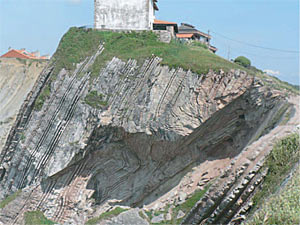UC Berkeley Press Release
Improved rock-dating method pinpoints dinosaur demise with unprecedented precision
BERKELEY – Scientists at the University of California, Berkeley, and the Berkeley Geochronology Center have pinpointed the date of the dinosaurs' extinction more precisely than ever thanks to refinements to a common technique for dating rocks and fossils.
The argon-argon dating method has been widely used to determine the age of rocks, whether they're thousands or billions of years old. Nevertheless, the technique had systematic errors that produced dates with uncertainties of about 2.5 percent, according to Paul Renne, director of the Berkeley Geochronology Center and an adjunct professor of earth and planetary science at UC Berkeley.
 At Zumaia in the Basque country of northern Spain, sediments laid down around the end of the Cretaceous period show layers of light limestone and dark marl reflecting warm and cool periods, respectively, in Earth's climate. These alternating climatic periods are caused by 100,000-year and 405,000-year cycles in Earth's orbital eccentricity. Because Earth's orbit, and thus the relative ages of the sediment layers, can be precisely calculated, dating of the sediments by the argon-argon method provided a much-needed recalibration of the method and made it possible to pinpoint the Cretaceous/Tertiary boundary at 65.95 million years ago. (Image courtesy of Science) |
According to a paper by Renne's team in the April 25 issue of Science, the best date for the Cretaceous-Tertiary, or K/T, boundary is now 65.95 million years, give or take 40,000 years.
"The importance of the argon-argon technique is that it is the only technique that has the dynamic range to cover nearly all of Earth's history," Renne said. "What this refinement means is that you can use different chronometers now and get the same answer, whereas, that wasn't true before."
Renne noted that the greater precision matters little for recent events, such as the emergence of human ancestors in Africa 6 million years ago, because the uncertainty is only a few tens of thousands of years.
"Where it really adds up is in dating events in the early solar system," Renne said. "A 1 percent difference at 4.5 billion years is almost 50 million years."
One major implication of the revision involves the formation of meteorites, planetessimals and planets in the early solar system, he said. Argon-argon dating was giving a lower date than other methods for the formation of meteorites, suggesting that they cooled slowly during the solar system's infancy.
"The new result implies that many of these meteorites cooled very, very quickly, which is consistent with what is known or suggested from other studies using other isotopic systems," he said. "The evolution of the early solar system - the accretion of planetessimals, the differentiation of bodies by gravity while still hot - happened very fast. Argon-argon dating is now no longer at odds with that evidence, but is very consistent with it."
Renne has warned geologists for a decade of uncertainty in the argon-argon method and has been correcting his own data since 2000, but it took a collaboration that he initiated in 1998 with Jan R. Wijbrans of the Free University in the Netherlands to obtain convincing evidence. Wijbrans and his Dutch colleagues were studying a unique series of sediments from the Messinian Melilla-Nador Basin on the coast of Morocco that contain records of cycles in Earth's climate that reflect changes in Earth's orbit that can be precisely calculated.
Wijbrans' colleague Frits Hilgen at the University of Utrecht, a coauthor of the study, has been one of the world's leaders in translating the record of orbital cycles into a time scale for geologists, according to Renne. Renne's group had proposed using the astronomical tuning approach to calibrate the argon-argon method as early as 1994, but lacked ideal sedimentary sequences to realize the full power of this approach. The collaboration brought together all the appropriate expertise to bring this approach to fruition, he said.
"The problem with astronomical dating of much older sediments, even when they contain clear records of astronomical cycles, is that you're talking about a pattern that is not anchored anywhere," Renne said. "You see a bunch of repetitions of features in sediments, but you don't know where to start counting."
Argon-argon dating of volcanic ash, or tephra, in these sediments provided that anchor, he said, synchronizing the methods and making each one more precise. The argon-argon analyses were conducted both in Berkeley and Amsterdam to eliminate interlaboratory bias.
Argon-argon dating, developed at UC Berkeley in the 1960s, is based on the fact that the naturally-occurring isotope potassium-40 decays to argon-40 with a 1.25-billion-year half-life. Single-grain rock samples are irradiated with neutrons to convert potassium-39 to argon-39, which is normally not present in nature. The ratio of argon-40 to argon-39 then provides a measurement of the age of the sample.
"This should be the last big revision of argon-argon dating," Renne said. "We've finally narrowed it down to where we are talking about fractions-of-a-percent revisions in the future, at most."
Klaudia Kuiper, the lead author of the Science paper, was a Ph.D. student in Amsterdam working with study coauthors Wijbrans, Hilgen and Wout Krijgsman when the study was initiated. She also conducted lab work with Renne and Alan Deino, a geochronologist with Renne at the Berkeley Geochronology Center who was also one of the study's coauthors.
The work was funded by the U.S. and Dutch National Science Foundations and the Ann and Gordon Getty Foundation.

